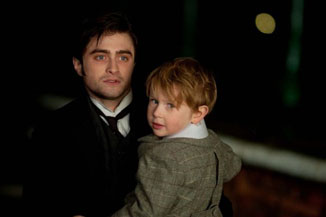|
|
Movie Review: The Woman in BlackBy Matthew HuntleyFebruary 9, 2012
Still, I expected the crescendos and just sort of shrugged them off. What I didn’t expect was the level of detail and atmosphere in The Woman in Black. This is one of the best looking horror movies to come out in a long time and is a superior example of how cinematography, production design and art direction can work together to create a distinct mood, which, in this case, is a combination of dread, fear and melancholy. One terrific shot occurs when Arthur is being transported across the marshes via carriage and we see the ashen mansion and its ominous grounds for the first time. The Eel Marsh estate is damp, dreary and unkempt, which complements the sadness and misery that fills the small town of Crythin Gifford, where almost everyone has been affected by the death of a child, including the hospitable Mr. Daily (Ciarán Hinds). The townsfolk clearly know something they’re not telling Kipps, but he suspects it has something to do with the spirit world, which gets substantiated when he learns Mrs. Daily (Janet McTeer) believes her dead son is trying to communicate through her. If that’s true, what is the son trying to say? Is he trying to warn Kipps or scare him away? That’s ultimately for you to find out, but these and other questions keep the story moving and I was pleased it didn’t rush toward its answers too quickly. Too many horror movies hastily dash to the next plot point because they assume the audience is in a hurry, which causes them to lose their effect. But The Woman in Black takes its time. We’re able to soak in the look and atmosphere as Kipps reacts to the phenomena happening around him. Through close-ups and small but effective touches like the reflection of candles in the eyes of stuffed animals and the careful framing of malevolent beings rising in the background, the movie evolves into a genuinely creepy and chilling experience. There have been better horror movies, but this is still a good one. As for Radcliffe, there came a point in the film where I stopped seeing him as “the kid who played Harry Potter” and just accepted him as his character. Because he’s inherently sympathetic and convincing as an actor, I had no problem believing he was a lawyer or a father. Perhaps Radcliffe can be an exception to the rule that all child actors can’t escape their claim to fame. Maybe all it takes is a sound story and gifted filmmakers. The Woman in Black has both.
|

|
|
|

|
Thursday, October 31, 2024
© 2024 Box Office Prophets, a division of One Of Us, Inc.


